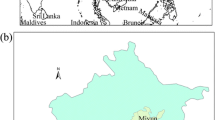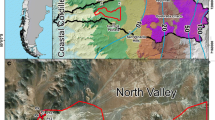Abstract
Groundwater management scenarios for the Toluca Valley, Mexico, are examined with a three dimensional groundwater flow model coupled to a one dimensional compaction module. The objective of this study is to establish a management policy for the sustainable development and management of the Toluca aquifer system for minimizing land subsidence. Several scenarios are tested by varying 4 main parameters: recharge, exports to other basins, local consumption, and relocating pumping centers. It is apparent that continuing at current rates of water consumption will lead to subsidence of more than 1.6 m over a 40 year period (2010–2050). Completely stopping exports to Mexico City is not the most important factor in controlling subsidence because the pumping system is mostly located in regions with low clay content, where subsidence is lower. However, decreasing exports by half and relocating the pumping centres to low-clay-content areas does have a positive effect on the overall water budget and subsidence. Based on simulation results, it appears that much of the land subsidence could have been avoided had water policies been applied to restrict pumping in regions with compressible materials. The approach taken in this study could be applied to other locations with similar problems in order to determine the most viable option for water supply.








Similar content being viewed by others
References
Ariel y Consultores (1996) Estudio de Simulacion Hidrodinamica y Diseno Optimo de las Redes de Observacion de los acuiferos de Calera, San Luis Potosi y Toluca (Tomo 3: Acuifero de Toluca). (Hydrodynamic modeling study and design optimization of the monitoring well networks for the aquifers of Caldera, San Luis Potosi and Toluca (Part 3: Aquifer of Toluca) CNA (Comisión Nacional del Agua) México, DF, Unitecnia 308
Bayer P, Duran E, Baumann R, Finkel M (2009) Optimized groundwater drawdown in a subsiding urban mining area. J Hydrol 365(1–2):95–104
Calderhead AI, Martel R, Allasset P-J, Rivera A, Garfias J (2010) Land subsidence induced by groundwater pumping, monitored by D-InSAR and field data in the Toluca Valley, Mexico. Can J Remote Sens 36(1):9–23. doi:10.5589/m10-024
Calderhead AI, Therrien R, Rivera A, Martel R, Garfias J (2011) Simulating pumping-induced regional land subsidence with the use of InSAR and field data in the Toluca Valley, Mexico. Adv Water Resour 34:83–89. doi:10.1016/j.advwatres.2010.09.017
Calderhead AI, Martel R, Garfias JR, Rivera A, Therrien R (2012) Pumping dry: an increasing groundwater budget deficit induced by urbanization, industrialization, and climate change in an over-exploited volcanic aquifer. Environ Earth Sci (Published online). doi:10.1007/s12665-011-1398-9
CNA (2002) Determinacion de la disponibilidad de agua en el acuifero Valle de Toluca (Determining the availability of water in the Toluca Valley Aquifer). CNA (Comisión Nacional del Agua) México, DF, Unitecnia: 26
CNA (2007) Comisión Nacional del Agua, Base de datos de los acuíferos a nivel Nacional y Regional. Comisión Nacional del Agua, Subdirección Nacional Técnica, Gerencia en el estado de México, 115 p. (National and Regional Aquifer Database Comisión Nacional del Agua. 115p. Internal information)
CNA (2008) Comisión Nacional del Agua. Registro de Lecturas Piezométricas para el Valle de Toluca, marzo 2008. Comisión Nacional del Agua, Subdirección Nacional Técnica, Gerencia en el estado de México, 60 p. (Register of the piezometric readings from the Toluca Valley, March 2008). Comisión Nacional del Agua. Public information
Figueroa Vega GE (1990) Estudio sobre el comportamiento reciente del acuifero de la ciudad de Toluca y su relacion con el problema de agrietamientos de la zona poniente de la misma (Study on the recent behavior of the Toluca aquifer and its relation to the problem of fractures in the western parts). CEAS, The state of Mexico, May 1990
Figueroa Vega GE (2004) El agrietamiento de la ciudad de Toluca, Consejo consultivo de Agua (The fractures of the city of Toluca, Water Advisory Council), December 2004
Galloway DL, Burbey TJ (2011) Review: regional land subsidence accompanying groundwater extraction. Hydrolog J 19(8):1459–1486
Gambolati G (1972) A three-dimensional model to compute land subsidence. Bullet Int Ass Hydrolog Sci 17:219–226
Gárfias J, Llanos H, Bibiano L (2008) Uso Racional y Sostenible de los recursos hídricos del acuífero del valle de Toluca. (Revista Ciencia Ergo Sum Rational and sustainable use of water resources in the Toluca valley aquifer. Science Magazine Ergo Sum), Vol. 15–1, May–June 2008, pp. 61–72
GEM (2000) Horizontes del Agua en el Estado de México. Secretaría de Desarrollo Urbano y Obras Públicas, Comisión del Estado de México (Water Horizons in the State of Mexico. Ministry of Urban Development and Public Works Commission of the State of Mexico), 160 p
Hancox J, Gárfias J, Aravena R, Rudolph DL (2010) Assessing the Vulnerability of over-exploited volcanic aquifer systems using Multiparameter Analysis, Toluca Basin, Mexico. Environ Earth Sci 59(8):1643–1660
Hawksworth J (2006) The World in 2050: how big will the emerging market economies get and how can the OECD compete? Pricewaterhouse Coopers, London
Helm DC (1975) One-dimensional simulation of aquifer system compaction near Pixley, California, 1, Constant parameters. Water Resour Res 11:465–478
IMTA (2003) Instituto Mexicano de Tecnologia del Agua . Censo del utilización del agua en el valle de Toluca. Organismo de Cuenca Lerma Santiago Pacífico de la Comisión Nacional del Agua (CONAGUA), Reporte interno, 110 p. (Water Use Census for the Toluca Valley, Mexican Institute for Water Technology (IMTA). Census Prepared for the Pacific Lerma Santiago Comisión Nacional del Agua (CNA), Internal Report, 110 p)
INEGI (2001) Síntesis de información Geográfica del Estado de Mexico (Sinthesis of Geographic Information for the State of Mexico) Instituto Nacional de Estadística, Geografía e Informática
INEGI (2005) Censo general de población y vivienda 2005 (General Census of Population and Housing 2005). Instituto Nacional de Estadística, Geografía e Informática
INEGI (2009) Síntesis de información Geográfica del Estado de Mexico/Aportación al Producto Interno Bruto (PIB) nacional (Sinthesis of geographic information for the state of Mexico/Contribution to Gross Domestic Product (GDP)) Instituto Nacional de Estadística, Geografía e Informática, http://cuentame.inegi.org.mx
IPCC (2007) Climate Change 2007: The Physical Science Basis. Contribution of Working Group I to the Fourth Assessment Report of the Intergovernmental Panel on Climate Change [Solomon, S., D. Qin, M. Manning (eds.)]
Larson KJ, Basagaoglu H, Marino MA (2001) Prediction of optimal safe ground water yield and land subsidence in the Los Banos-Kettleman City area, California, using a calibrated numerical simulation model. J Hydrol 242(1–2):79–102
Leake SA, Galloway DL (2007) MODFLOW ground-water model—User guide to the Subsidence and Aquifer-System Compaction Package (SUB-WT) for water-table aquifers: U.S. Geological Survey, Techniques and Methods 6–A23, 42 p
Legorreta J (1997) Rainfall, the key to the future of the Valley of Mexico. La Jornada Ecologica 5(58):1–12
Lesser y Asociados, S.A. (1992) Estudio para el Diagnostico del acuifero del Valle de Toluca, para implementar la reglamentacion de la extraccion del agua subterránea. (Diagnostic study of the aquifer of the Valley of Toluca to implement a program for the extraction of groundwater)
Loukas A, Mylopoulos N, Vasiliades L (2007) A modeling system for the evaluation of water. Resources management strategies in Thessaly, Greece. Water Resour Manage 21:1673–1702
McLaren RG (2005) User Guide: GRID BUILDER A pre-processor for 2-D, triangular element,finite-element programs, University of Waterloo - Groundwater Simulations Group
Metropoli (2008) Pierde Edomex batalla legal sobre acuíferos. In: Metropoli (Editor). Metropoli, Mexico, Mexico, last accessed Nov, 2011. http://ciudadanosenred.com.mx/node/3399
OEE (1970) Los acuíferos del alto Lerma pub. No. 7, (The upper Lerma Aquifers pub. No. 7). report for Oficina de estudios especiales (OEE) of the CHCVM-SRH
Ortega-Guerrero A, Rudolph D, Cherry J (1999) Analysis of long-term land subsidence near Mexico City: field investigations and predictive modeling. Water Resour Res 35(11):3327–3341
Rejani RM, Jha K, Panda SN, Mull R (2008) Simulation modeling for efficient groundwater management in Balasore Coastal Basin, India. Water Resour Manage 22:23–50
Rivera A, Ledoux E, de Marsily G (1991) Nonlinear modeling of groundwater flow and total subsidence of the Mexico city aquifer-aquitard system. FISOLS (IV International Symposium on Land Subsidence), vol. 20. IAHS Publication, Houston Texas, pp 45–58
Rudolph DL, Frind EO (1991) Hydraulic response of highly compressible aquitards during consolidation. Water Resour Res 27(1):17–28
Rudolph DL, Sultan R, Garfias J, McLaren RG (2006) Significance of enhanced infiltration due to groundwater extraction on the disappearance of a large wetland system: Toluca Basin, Mexico. Hydrogeol J 14(1–2):115–130
Sakiyan J, Yazicigil H (2004) Sustainable development and management of an aquifer system in western Turkey. Hydrogeol J 12:66–80
Teatini P, Ferronato M, Gambolati G, Gonella M (2006) Groundwater pumping and land subsidence in the Emilia-Romagna coastland, Italy: modeling the past occurrence and the future trend. Water Resour Res 42:W01406. doi:10.1029/2005WR004242
Therrien R, McLaren G, Sudicky EA, Panday SM (2009) User Guide: HydroGeoSphere - A Three-dimensional Numerical Model Describing Fully-integrated Subsurface and Surface Flow and Solute Transport
UNEP (2008) Mexico’s Annual population Growth Rate. United Nations Environment Programme data, http://www.unep.org/
Acknowledgements
We are thankful to the Ministère des Relations Internationales du Québec, INRS-ETE, NSERC (a discovery grant held by Richard Martel), the Autonomous University of the State of México (UAEM), CONACyT, AUCC/IDRC, and the Ministère de l’Éducation du Québec for their financial support. We are appreciative of Sergio Murillo from the Commission National del Agua for logistical support on the field.
Author information
Authors and Affiliations
Corresponding author
Rights and permissions
About this article
Cite this article
Calderhead, A.I., Martel, R., Garfias, J. et al. Sustainable Management for Minimizing Land Subsidence of an Over-Pumped Volcanic Aquifer System: Tools for Policy Design. Water Resour Manage 26, 1847–1864 (2012). https://doi.org/10.1007/s11269-012-9990-7
Received:
Accepted:
Published:
Issue Date:
DOI: https://doi.org/10.1007/s11269-012-9990-7




